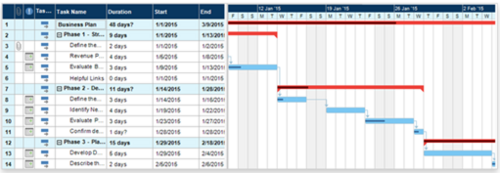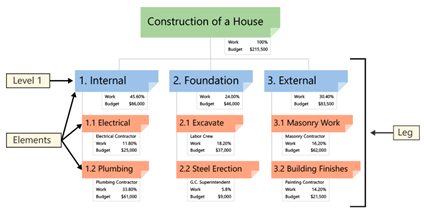Work break down structure (WBS)
(→Abstract) |
(→References) |
||
| Line 69: | Line 69: | ||
== '''References''' == | == '''References''' == | ||
| − | [ | + | [https://sd.ds.dk/Viewer?ProjectNr=M351700&Status=60.60&Inline=true&Page=1&VariantID=.[1]]ISO Standard 21502, Project Management |
| − | [https://learn.inside.dtu.dk/d2l/le/content/102752/viewContent/401279/View.[2]] Course notes, Author: DTU ProjectLab, 42430 - Week 2 - Part 3 - Complexity slides | + | [https://learn.inside.dtu.dk/d2l/le/content/102752/viewContent/401279/View.[2]] Course notes, Author: DTU ProjectLab, 42430 - Week 2 - Part 3 - Complexity slides |
| − | [https://www.workbreakdownstructure.com/.[3]] | + | [https://www.workbreakdownstructure.com/.[3]] Visualization of Work Breakdown Structures, Author: WorkBreakdownStructure.com |
| − | [https://www. | + | [https://www.workbreakdownstructure.com/.[4]] Figure 1: Picture of tree schedule, Author: WorkBreakdownStructure.com |
| − | [https://www. | + | [https://www.adeaca.com/blog/faq-items/what-is-a-work-breakdown-structure/.[5]]ADEACA, What is a work breakdown structure?, Author: Matt Mong |
| + | |||
| + | [https://www.gantt.com/.[6]]Figure 2: Picture of Gantt Chart, Author: Roger Duke | ||
Revision as of 17:16, 20 March 2022
Contents |
Abstract
Taking on a project can be a confusing task for even the most experienced project manager. In the start-up phase of a project the goal is defined, and it is expected to estimate a budged and a timeframe of the project. Often several things will happen doing the elapse of the project, that in the end will lead up to the final reaching of the project goal or scope. To create a better view of the project it can be helpful to part the project and the goal onto sub-goals or sub-events – to break down the project. By estimating the timeframe and budget of the sub-events or sub-goals, the timeframe of the project can be estimated as well as the budged. This method is referred to as Work Breakdown Structure (WBS), as it is a way to structure the project by breaking it down. This is the addressed subject of this article.
The article consists of the following sections:
- What is Work Breakdown Structure?
- Why is Work Breakdown Structure an important tool in project management?
- How to implement Work Breakdown Structure
- What are the limitations of Work Breakdown Structure?
In each section, the question will be answered.
This article is a part of the final deliverable in the course 42433 Advanced engineering project, program and portfolio management taught in the spring of 2022 on DTU. It is written by a student for other students taking the same course and with an academic background corresponding to a bachelor’s degree.
What is Work Breakdown Structure?
A work breakdown structure is defined by the ISO Standard 21502 as "decomposition of the defined scope of a project or programme into progressively lower levels consisting of elements of work" [1]. In other words: when the scope of a project or programme is defined in the very beginning of this project- or programmes lifespan, it might be favourable to look at the work that is needed in order to fulfil the scope and deliver on the project/programme.
When planning the project, an estimation of time or deadline is needed as well as a budget including every expense throughout the project. This expense covers resources, salary and administrative fee as well as setting a realistic amount of money aside for unforeseen occurrences. The process of estimating time and budget is essential in order to evaluate whether the scope of a project is achievable as these two subjects are the backbone and key factors of a project. This is the factors the important stakeholders and investors of a project will evaluate the project on. If the important stakeholders and investors does not find that the scope of a project equalize the time needed and the budget estimated, the project will in all probability not been initiated. A Work Breakdown Structure is often visualized as a schedule or a table. The schedules or tables can have different structures. For instance, the schedules can be formed as a tree structure or a waterfall model. The tables can be made as hierarchies or outlines. Common to all this different schedules and tables is what they should include; [2]
- A description of the work that needs to be done to achieve the sub-goal. The work needed to achieve the sub-goals that occurs when breaking down a project into smaller projects is seen as smaller work packages or works. - The product produced by the work done in a work package. It is important to match the expectations of the work between the project manager, the stakeholders, and the person reasonable for the work. - The cost of the work done. Both in terms of resources needed, salaries for the workers and other payments. - Who is responsible for the work and thereby responsible for the quality of the delivered product.
Why is Work Breakdown Structure an important tool in project management?
The Work Breakdown Structure is an important tool for a project manager when estimating a time schedule and budget of a project as already stated. When breaking down the work into smaller projects or work packages an overview of the project is created. It is giving the project manager the ability to analyses the needs of a work package or a sub-goal of the project in terms of workload, resources needed, risks linked to the specific work and preparations needed to fulfil a certain work. The work packages or smaller projects can be scheduled in a model such as a schedule or table. This is in fact what makes the Work Breakdown Structure a great tool, as an overview of the hole project is secured and estimated. Also, this way of scheduling the work in smaller work packages makes it easier for the project manager to watch out for delays on curtain areas of the project, inform the different stakeholders and investors and handle the work-, risk- and resources-flow as the project proceeds.
How to implement Work Breakdown Structure
The Work Breakdown Structure should be implemented in the planning of the execution of a project. To what extent the work should be broken down and the level of details planed in every work package or sub-project depends on the size of the project. The bigger the project is, the more risks will occur. The more risks in the project, the more planning is needed in order to fulfil the project scope to a satisfactory extend. When something goes wrong, it must be detected as quickly as possible and dealt with. This is easier if the work and project is scheduled to a proper degree of details for the size of the project.
How to implement the Work Breakdown Structure depends on the needs of the project manager. One way to implement this is by making a tree structures schedule as seen in figure 1. The project scope is shown on top of the schedule. Underneath the scope is broken down into smaller works, that is needed to fulfil the overall scope of the project. These smaller works are again broken down into smaller works and analysed for cost and work. Then the small works are analysed the total cost of the project can be summed.
Figure 1: Tree structured Work Breakdown Structure Schedule. This shows the scope of the project is broken down into smaller scopes and how these smaller scopes are broken down into even smaller scopes. [3]
Another way to implement Work Breakdown structure is to use a Gantt Chart. In order to do so, the project must of course be divided into smaller projects or sub-goals. These tasks are then organized in area of work, contact person and firm. It is also important to state who is responsible for the sub-goal to be finished to the expected time and at the agreed quality. Then this is examined, it is identified if any of the works or sub-goals or deliverables are overlapping and which of the works that are depending on each other. These works must be done in a certain order. After this identification, the time estimated for each work is determined and the works are ready to be scheduled.
This can be done in two ways; Firstly, it can be done from the starting point of the project. The works are then scheduled from a date and forward until the estimated time for the given work is up. This step needs to take in to account, that holidays may occur in the timespan of the project. When a deadline is set for one work, the next work dependent on the first work can be scheduled and so on. The second way to do the time-scheduling is to begin from the deadline of the project and do the scheduling backwards. This is a good way to optimate the timespan of a project, because this provides the project manager with the fasted time schedule in a natural way. An example of a Gantt Chart can be seen in figure 2.[4]
Figure 2: Gantt Chart. It is seen that the chart provides a timeline for the project. This is a great way to get an overview of the works that needs to be done in a specific order, or at the same time. [5]
Common to the two ways to schedule a Work Breakdown Structure is that both of them brings an overview of the project.
What are the limitations of Work Breakdown Structure?
As a project manager it is important to know what you don’t know - and to expect the unexpected. A Work Breakdown Structure of a project might give a great overview of a project but as much as this scheduling of the smaller work packages provides a sound estimation of the project, everything can still go wrong. The overview provides a good opportunity to do risk analysis on the project in details. It is also a good way to keep track of the time spend on the project and the different work packages. On that note it is easy to keep track of deviations from the schedule early in the process and act on these to provide some kind of damage control.
To summarize: The Work Breakdown Structure is a good way to make a sound estimation of a project in terms of timespan and budged. But as a rule of thumb, something will deviate form the project plan at some point doing a project. A good Work Breakdown Structure schedule will provide an overview for the project manager, who in case of deviation from the schedule can act on them at an early state and reduce any harm to either the product delivered in the end, the time schedule, or the budget. As so, a Work Breakdown Structure can be seen as a work in progress and not a finished product.
References
[1]ISO Standard 21502, Project Management
[2] Course notes, Author: DTU ProjectLab, 42430 - Week 2 - Part 3 - Complexity slides
[3] Visualization of Work Breakdown Structures, Author: WorkBreakdownStructure.com
[4] Figure 1: Picture of tree schedule, Author: WorkBreakdownStructure.com
[5]ADEACA, What is a work breakdown structure?, Author: Matt Mong
[6]Figure 2: Picture of Gantt Chart, Author: Roger Duke

